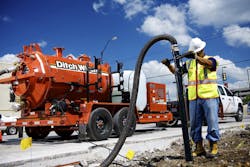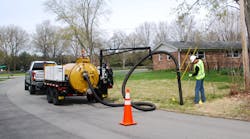Vacuum-excavating systems, whether using high-pressure water or compressed air as the digging medium, have a wide range of application.
For example, Bill Petrole, vice president, Vacall, Gradall Industries, tells about a Texas contractor who took on the job of stabilizing pylons under a large building that was beginning to sink. Among the first tasks was excavating material from around the pylons—a delicate operation made more difficult in the close confines under the building. The contractor chose “hydro-excavating”—loosening soil around the pylons with high-pressure water and evacuating the spoil with a powerful vacuum—the vacuum hose stretching long distances to reach some locations.
A suburban-Chicago fire department, some time back, demonstrated the potential of “air-excavating” in trench rescue. Firefighters first placed pneumatic shoring to stabilize the collapsed trench, then used the air-excavating system to open a pit near the victim (a CPR dummy). They placed the vacuum hose over the pit, safely away from the victim, then carefully directed the entrapping material away from the victim and into the pit with an air lance. One firefighter stood ready to open a quick-release vent on the vacuum if anyone saw a problem and signaled with a raised hand. (The AirSpade air lance used in the demonstration is now manufactured by GuardAir Corp., which markets the AirSpade 2000 Trench Rescue Kit.)
Most hydro- and air-excavating systems, however, are used for more mundane—but nonetheless important—jobs. For instance, potholing—digging relatively small holes to locate underground utilities—is a frequent use of vacuum-excavating. But applications can range from digging in utility poles, fence posts, and pylon foundations, to small-scale trenching, pipeline maintenance, soil-remediation, and initiating excavations in frozen ground (using hot water from an on-board boiler). In addition, vacuum-only applications frequently include removing fluid tailings from horizontal-directional-drilling sites and dewatering excavations.
Differing designs
The basic design of vacuum-excavators varies by manufacturer, some preferring water as the primary excavating medium, others preferring air, and some offering both types in different models. Most manufacturers will supplement the unit’s primary medium with the other as an option, and some have standard “combination” models in their line capable of using either water or air. According to Vacall’s Petrole, however, most buyers choose one or the other.
A primary design difference among these machines is the mechanism that actually draws the vacuum, typically either a positive-displacement blower or a centrifugal compressor. The blower uses a pair of shaft-mounted rotors—each rotor usually having two or three lobes that mesh with those of its counterpart. The centrifugal compressor, sometimes called a “fan,” uses a bladed wheel (or a series of bladed wheels) to produce vacuuming forces.
As the blower or fan rotates at high speed, it creates two forces: airflow (sometimes called the unit’s “rate”), which is measured in cubic feet per minute (cfm); and “lift” (suction), which typically is measured in inches of mercury (Hg) for the blower and inches of water for the fan. (An inch of mercury equates to 13.6 inches of water.)
The higher the rate, the faster the vacuum can pull in material; the greater the lift, the heavier the material that can be pulled in. Typically, a unit’s rate and lift are correlated with the diameter of its vacuum hose and the output of its water pump (hydro) or compressor (air) to optimize excavating performance. In round numbers, trailer-mounted units might have 15 or 16 inches (Hg) of lift and airflows to 1,300 cfm with up to a 5-inch hose. Truck-mounted units, depending on hose diameter, might have lift ratings between 15 and 27 inches (Hg) and airflows of 1,200 to 5,500 cfm.
Also, rate and lift are inversely related; as material collects in the hose, the rate diminishes and lift increases; as the hose clears, the rate increases and lift diminishes. When comparing specifications, note that some manufactures provide an airflow figure at both maximum and minimum lift—the latter called the “free-air” rating.
Manufacturers of vacuum-excavating machines debate the relative merits of the positive-displacement blower and centrifugal compressor, some saying that the blower is more capable of vacuuming heavier materials. Fans might provide a higher cfm, say blower proponents, but can’t provide the lift of the blower. Others say that both approaches are viable—just different ways of doing the same job. Some manufacturers give buyers a choice of blower or fan.
The method of driving the blower or centrifugal compressor—and the method of driving the water pump (hydro-excavating) or the air compressor (air-excavating)—also reflects different design approaches. Comparing how these components are driven in two different brands of truck-mounted (versus trailer-mounted) hydro-excavating machines serves to illustrate.
One machine uses the chassis (truck) engine to drive its centrifugal compressor via a hydrostatic system (using a hydraulic pump and motor), but uses a separate engine to drive the water pump. The second manufacturer uses the carrier truck’s single engine to drive a mechanical transfer case in the truck’s drive train. The blower is powered via a drive shaft from the transfer case, and the water pump is driven hydrostatically from a PTO on the transfer case. Just to mix things up a bit, the first manufacturer also builds truck-mounted units with the single (chassis) engine driving both the fan and water pump hydrostatically. Another manufacturer makes no use of the truck engine and uses a high-horsepower industrial engine in the rig to power vacuum, air, and water functions.
Still another area of differing design is the debris-tank filtration system, which protects the blower or centrifugal compressor from material pulled into the tank. Manufacturers typically have proprietary filtration-system designs, which might consist of differing arrangements of deflectors to initially slow airflow and cause solids to drop out, multiple “cyclonic” devices that spin out heavier particulates, and final filters of various media to catch the smallest particles. Filtration systems in units capable of both water and air excavating must be capable of handling both wet and dry spoils effectively.
Air or water excavation?
Opinions differ among manufacturers about which excavating medium, water or air, is most advantageous. Trevor Connolly, vice president, Vacmasters, explains that an air-vacuum system pushes air into the minute fissures of soil, while the air is still in a compressed state, and as the air expands, it breaks apart the soil into easily vacuumed particles. The effectiveness of the process, he says, depends on proper correlation of air pressure and air volume to the size and shape of the nozzle on the air lance. These parameters change, he says, depending on the size of the compressor.
“We think there are inherent problems digging with water,” says Connolly. “Foremost is that the spoils tank is filled with slurry at the end of the day. The slurry needs disposing, and sometimes must be handled as a hazardous material. This not only involves time, fuel costs, and charges for disposal, but also requires hauling in backfill, resulting in added costs for material and transport. With air, the spoil stays dry and can be used as fill. Water is indiscriminate and can damage some utilities; when an airstream encounters the non-porous shielding of a utility, it compresses and harmlessly flows around it.”
In the opinion of Jason Proctor, product manager, vacuum excavation systems, Ditch Witch, a company that offers both types of systems, “water is the preferred medium, because it’s more productive in more types of soil. The downside is the downtime associated with hauling off wet spoil. Air is a great alternative, but not as productive in many types of soil.”
Jeff Wage, vice president, McLaughlin Group, manufacturer of Vermeer-branded vacuum-excavating systems, adds that “hydro-excavation works significantly better than air in clay-soil conditions, and water is generally faster for excavating. Another advantage,” he says, “is that it allows contractors to work in the winter months and excavate when there is frost in the ground. Air is good in granular conditions and when reusing spoil is advantageous.”
According to Mike Selby, inside sales manager, Vac-Con, “air has application around high-pressure gas lines, some high-power electrical transmission lines, and in areas where water spray would be detrimental to the environment. Water is good for hard soils, frozen ground, or where dust abatement might be necessary. With air, however, there is usually higher wear from the material, because you no longer have water to lubricate the suction piping.”
Selecting a vacuum excavator
“Most commonly,” says Ditch Witch’s Proctor, “the customer is looking for cfm as far as vacuum performance is concerned—that is, how quickly can material be pulled in. But if the work site is at an extended distance from the vacuum, then the user needs to look at lift to ensure that the vacuum can pull in the material. If the truck were on a bridge, for example, and the hose had to be dropped down to excavate, then more lift would be required.”
A basic decision to make about vacuum-excavating systems is whether a trailer-mounted or truck-mounted unit makes more sense.
“The buyer looking at a trailer is often looking to save money,” says Vacall’s Petrole. “Trailer buyers might do a 15- or 16-inch [Hg] blower with a relatively high cfm rating. The logic is that runs are generally short, the diameter of the hose is not large, and you want to keep the engine small to reduce weight and cost. The larger the blower, the more horsepower required, and the greater the cost.”
When contemplating trailer- or truck-mounted models, Proctor reminds buyers that truck models usually have an overall smaller footprint, thus can work more easily in urban areas, and that truck-mounted models usually have a higher payload. He adds the caution, however, that buyers should be certain that when the debris tank is filled with the heaviest material, the truck has axle ratings to handle the weight and that it conforms to load-weight regulations. Keep in mind, too, he says, that the truck must remain legal even when towing additional equipment, such as trenchers, drills, or mini excavators.
When considering trailer-mounted units, the consensus is that the buyers should first investigate how well the trailer is constructed and if it complies with federal on-road standards. Then, consider if existing towing equipment is adequate to handle the trailer, safely and in compliance with regulations, and whether employees will need a commercial driver’s license to operate the truck/trailer combination.
“An increasing number of contractors are working to ensure that trucks will pass DOT inspection,” says McLaughlin’s Wage. “Bridge laws and axles weights remain critical considerations.”
Buyers of vacuum-excavating units have a number of considerations to keep in mind when choosing a unit, says Vacall’s Petrole.
“First, determine how much vacuum excavating you’re really going to do, and consider the type of soil you’ll be working in—black dirt in Milwaukee is easier to handle than clay and rock in Ohio. What size debris tank do you need? Do you want to reuse spoil? Where will you dump wet spoil? What are the travel distances involved and the local weight regulations? Also, do you plan to work year-round? Will you need a boiler, heated water lines, a heated cabinet for the rig’s hardware, or space for the operator to warm up?”
McLaughlin’s Wage says that, ultimately, the selection of a system should be a balance between the most productivity achievable for the capital deployed within the budget, taking into account the material sizes that will typically be encountered (what’s the optimum hose size?), debris-tank size (can you stay on the job for a full day?), and the footprint of the tow vehicle or truck and its road-regulation compliance.


